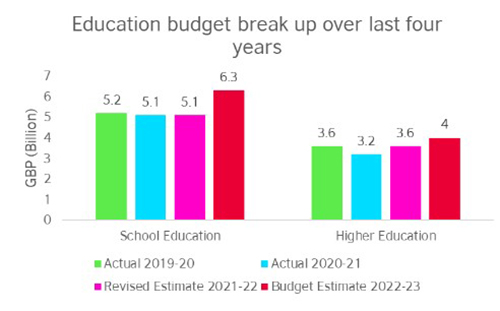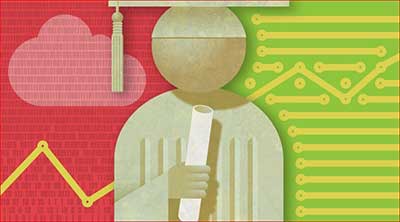Date: 05/11/2022
Relevance: GS-2: Education, Government policies and interventions for development in various sectors
Key Phrases: Underinvestment, administrative and financial health, University Grants Commission, public exchequer, CAGR, Public Financial Management System, National Institutes of Technology.
Context:
- Public-funded higher educational institutions seem to be in a crisis situation due to chronic underinvestment.
- Central universities and other centrally-funded institutions of higher education were thought to be better funded, but it is not true anymore.
Indian Higher Education System
- India has one of the largest higher education systems in the world that stands second in terms of the higher education network.
- The term ‘higher education’ with respect to India denotes the tertiary level education that is imparted after 12 years of schooling (10 years of primary education and 2 years of secondary education).
- The entire higher education ecosystem in India comprises around 1000+ universities and 42,000+ colleges imparting exceptional education.
- All these institutions fall under the purview of the Ministry of Education.

Types of Universities
- On the basis of management the universities are classified as:
- Central Universities: These are set up through an Act in Parliament. The establishment and operation are funded by the Union Government.
- State Universities: These are set up through an Act in the State Legislature. The state universities are primarily funded and operated by the State Government.
- Private Universities: Private universities and private colleges are institutions of higher education, not operated, owned, or institutionally funded by governments. They may (and often do) receive from governments tax breaks, public student loans, and grants. Depending on their location, private universities may be subject to government regulations.
- Deemed Universities: These are well-performing institutes that are declared to be of equal standing as the universities by the Central Government on the advice of the Union Grants Commission (UGC).
- Institutes of National Importance (INI): These are eminent institutions of India that are known to develop highly skilled individuals. They are funded by the Government of India and include all the IITs, NITs and AIIMs institutes.

The Regulatory Structure
- The entire ecosystem of higher education in India is primarily overseen by the following authorities.
University Grants Commission (UGC)
- The main regulatory body that performs a range of tasks such as providing funds to the universities, establishing education standards for the universities and analysing the growth of the various higher education institutions.
- It is crucial for universities to meet the criteria set by UGC so as to enjoy degree-awarding authority.
All India Council for Technical Education (AICTE)
- The regulatory body that coordinates, plans and develops technical education in the country.
- Finally, the accreditation of the universities and colleges is overseen by the NAAC and NIRF.
Challenges in India’s Higher Education:
- Teaching Quality
- The first issue that higher education in India is facing is decreasing teaching quality.
- Teachers are not well trained and qualified for the job they are assigned to some colleges recruit young graduates as professors who have no experience or knowledge. So this is a big problem.
- Poor Women's Education
- Women have a much lower literacy rate than men. Conservative cultural attitudes prevent girls from attending schools.
- Political Factor
- Political influence is also a bad thing and an issue with higher education.
- The dominant political leaders, now play key role in governing bodies of the Universities, as they own most of the Institutions, imparting education (Aided-non-aided).
- Corruption in Education
- Corruption in Indian education system has been eroding the quality of education. It is one of the major contributors to domestic black money.
- Curriculum issues
- There are many different curriculum systems that confuse the students who wish to achieve the same objective such as Engineering, Medical and Business Administration.
- Lack of proper disbursement of Grants:
- The University Grants Commission (UGC) claims that grants have increased by many thousand folds.
- In 2020-21, for example, it was 4,781 times the figure of 1955-56. Even as a proportion of GDP at factor cost, UGC funding went up from 0.02% in 1955-56 to 0.05% in 2020-21.
- However, this ignores the growth in our higher education system.
- Universities have surged from 38 to 1,050, colleges from 1,025 to 40,000, and enrolment from 295,000 to 38.5 million.
- Discounting inflation and capacity growth, grants may have declined in real terms.
Way Forward:
- Give Importance to Technology in Education:
- India has to embrace computer and high speed internet technology. Our educational delivery mechanisms should take the wealth of human capital to the masses.
- The Governments should invest more in technological infrastructure that will ease the knowledge accessibility.
- Encourage Innovation and Creativity:
- The system should reward those who deserves highest academic honor.
- Our testing and marking systems need to be built to recognize original contributions, creativity, problem solving and innovation. Ranks should be awarded accordingly.
- Personalize the Education:
- Indian education system is built on the assumption that if a thing is good for one child, it is good for all. But, one massive education system cannot be suitable to all. Some people are visual learners, others are auditory learners.
- Some kids learn faster, some do slow. The syllabus should be designed in such a way that every learner’s latent ability is identified and motivated.
- Train the Trainers Continuously:
- A teacher is an entrepreneur and creator. The performance of a teacher should not be restricted to classroom.
- It needs to be opened up for the world to see with internet.
- There has to be leaders in teaching positions, not salaried people holding their mantle. Hence, regular training is a necessity.
Do you know?
- For 2022-23, the budget for school education spending is GBP 6 bn (INR 63,449 crore) and has increased by 22 per cent over its previous year’s revised allocation.
- The higher education budget has also increased by 13 per cent over its previous year’s allocation and is GBP 4 bn (INR 40,828 crore).
- According to the report published by the National Survey of India, the Literacy Rate of India in 2022 is 77.7 per cent.
Conclusion:
- The overall culture, tradition, heritage, spirit, and inclination towards creativity and innovation make India a great study destination for higher education.
- However, expensive education leaves students with no option but to take student loans, many of which are fast turning non-performing.
- It is time to recall the proven wisdom that a grant-in-aid system is the cheapest mode of public funding for higher education.
- Other methods are not only cumbersome, but also more costly to the public exchequer.
Sources: Live-Mint
Mains Question:
Q. Discuss the state of higher education in India. Why we have only few Universities in top 100 Universities of the world? (250 Words).








